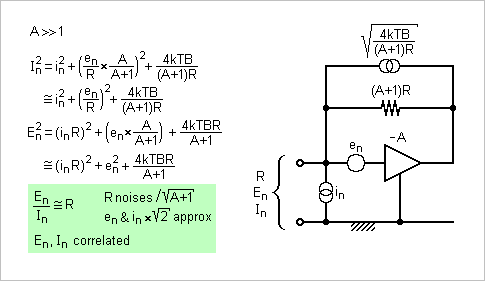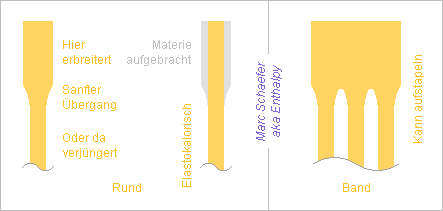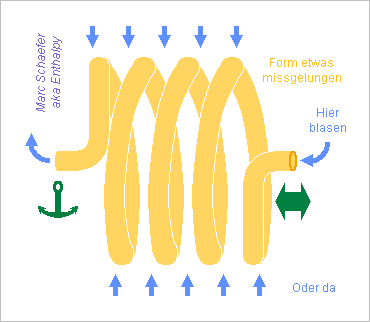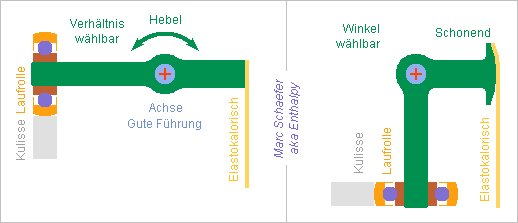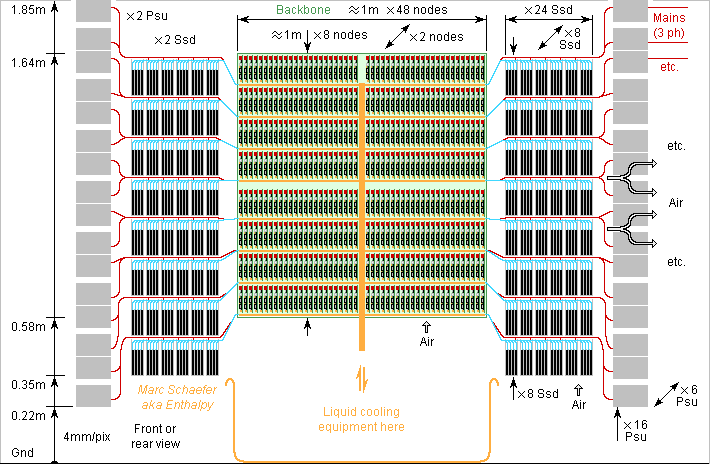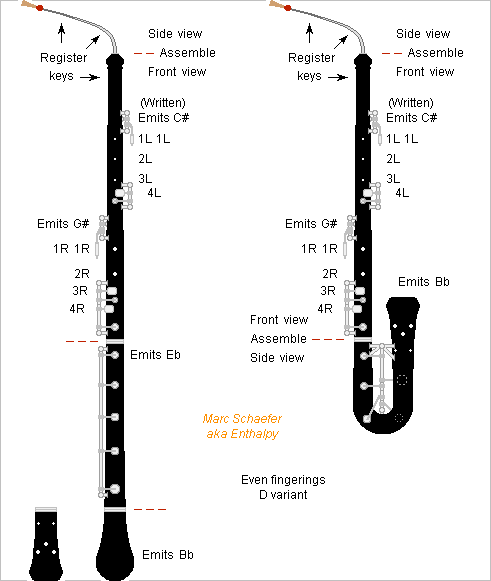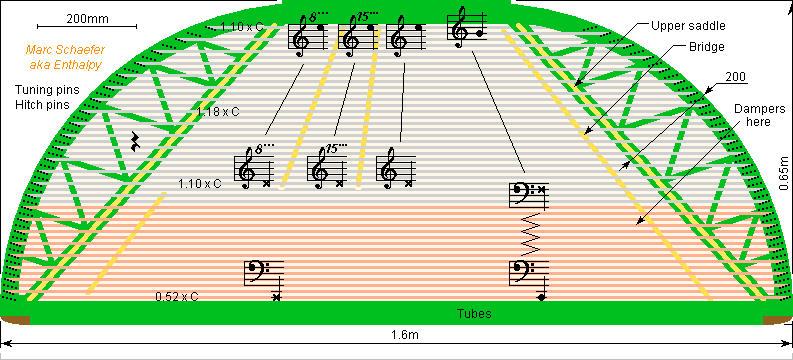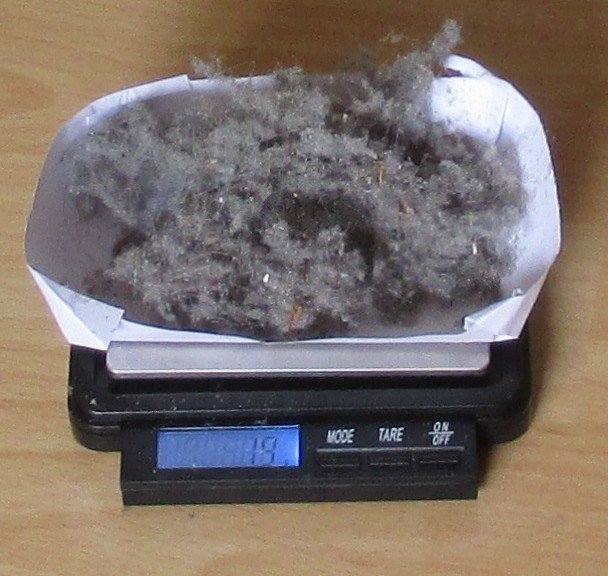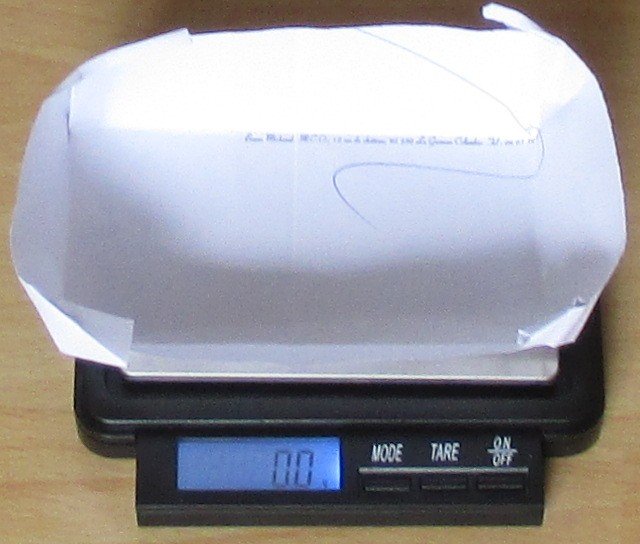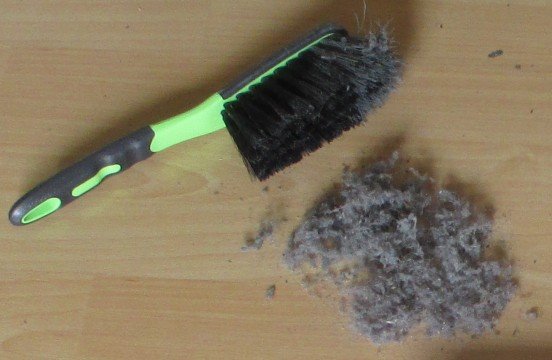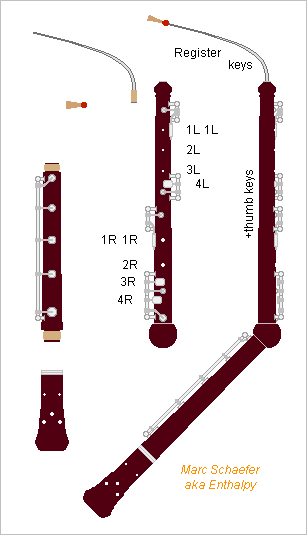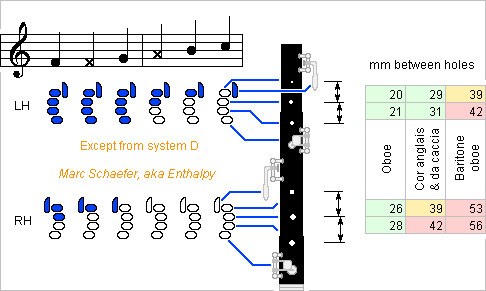-
Posts
3887 -
Joined
-
Last visited
-
Days Won
1
Content Type
Profiles
Forums
Events
Everything posted by Enthalpy
-

venturi effect with electric field component.
Enthalpy replied to DandelionTheory's topic in Engineering
Hi DandelionTheory, I regret to tell you that your diagrams are not understandable, or at lest not by me. Nor do I see what venturi effect shall be here. Thrust from electrodes in air was demonstrated. When Jean-Pierre Petit showed his setup, people laughed, supposedly by Pavlov conditioning because some of his other theses are not mainstream. Later, a known US university showed about the same effect and setup, and the same people admired the astounding demonstrator, without even asking if the figures were practical. Maybe you could check Jean-Pierre Petit's demonstrator? He made a video of it, and he's excellent at explaining science in simple terms - alas not in English. Perhaps on his website. -
The launch and orbit configurations differ. The deployed solar arrays, the ridiculous trusses that hold them, have no single chance to withstand 1g. All is rolled and folded to a compact sturdy shape during launch.
-
Hello dear friends! I believe it is known, but not universally: a quiet amplifier can synthesize a quiet resistor that produces less noise than a physical resistor at the same temperature. Amplifiers can be very quiet. Under S/N=3dB they add less noise than a resistive source at 300K produces. Good RF preamplifiers of usual technology at room temperature can offer S/N=0.8dB, adding 20% to the noise power of a resistive source. Cooled or exotic RF preamplifiers can be much better. Audio amplifiers can add even less noise, especially FET amplifiers on a high-impedance source. Here the amplifier with gain -A shall have a high input impedance to simplify the computations. This is consistent with an AF bipolar transistor biassed for best noise or with a FET. A feedback resistor of value (A+1)R results by Miller effect in a stage input resistance of R, the synthesized quiet resistor. The noise resulting from the feedback resistor is sqrt(A+1) times smaller than what a physical resistor R produces, both in voltage and current. The setup increases the noise injected by the amplifier in the input. It adds quadratically en/R to the amplifier's in and in*R to en, but their contributions to the setup's En and In are fully correlated. If the synthesized resistance R is the amplifier's optimum en/in, then the setup nearly quadruples the amplifier's noise power. With an amplifier better than S/N=1.0dB, the setup can be quiter than a physical resistor. Noise computations are slippery, so double-checkers are even more welcome than usually! Marc Schaefer, aka Enthalpy
-
While sunlight can make heat and evaporate seawater to obtain sweet water, this is a waste. Separating water from salt takes very little energy, but evaporating water takes much. At least at identical sunlight collecting area, it's better to run water pumps from sunlight, possibly over electricity, and have reverse osmosis remove the salt. Then you have to compare the costs, where replacing a plastic sheet by solar cells isn't obvious. The current heavy trend in favour of reverse osmosis tells it's globally cheaper. Reverse osmosis works so nicely that it does provide sweet water on city scale. It's used in Canarias (Spanish isles) and Israel at least. I believe it's powered by sunlight at least in Canarias, but it could use any power source. A big project exists to let seawater flow from the Red sea to the lower Dead Sea to avoid its disappearance, turbine the water to make electricity, and use a part of the electricity to desalinate some water.
-
Sure. Over a short distance, a magnetic field lets communicate. Advantage: it doesn't interfere at longer distance. Disadvantage: only few decametres. Or by light if we accept to be in direct sight. Exists to spread the Internet access in a room. What shall "new" physical principles be? Technology can develop "new" toys without needing new physics. Physics can explain new effects without discovering new forces. Problem of the whole topic is, we ignore what technology will look like in 50 years. Nobody predicted Internet so long in advance. Many thousand people think long and hard to make new toys available in 10 years, I don't believe we'll find in 5 min the ones available in 50 years. Besides the fixed directional antennas pointed by Sensei, there are antennas with aperture synthesis. They form transmission and reception beams by combining many small elements with the proper phase and optionally amplitude. These can easily adapt to a moving target and were developed for radars. The serve increasingly for Wifi presently. A limit is diffraction. It takes an antenna many wavelength wide and high to concentrate a beam at a target many wavelength away. 0.1m microwaves are inefficient for that, and directional antennas can only reduce the waste. Light is better, and several satellites communicate per laser presently. Cell phones are too small to make good aperture synthesis (or beam forming) with microwaves. At best, they could have few antennas close to an other and radiate in all dimensions like a small dipole. More efficient pattern, but the antennas themselves get less efficient. The range varies in a complicated fashion with the frequency. Between some 3MHz-20MHz you can reach the antipodes. Over 30MHz you're more or less limited to the horizon. But in direct sight like in outer space, it you can direct big antennas properly, higher frequencies give a more efficient transmission. That's one reason for ever higher frequencies. Though, atmospheric absorption limits to about 40GHz on Earth, with an other window around 94GHz. Displacement current serves in every electromagnetic wave. It's dE/dt that relates with curl(B). It's also what lets ceramic (or "dielectric") antennas work in cell phones. There is some misunderstanding about that, but vacuum's displacement current at an antenna creates no distant EM wave, while the displacement current added by a dielectric results from charge movement and these radiate. Resonance of air molecules creates losses. This limits long-range transmissions to 40GHz. Several cutoffs exist that relate to moisture, oxygen and more. Do you mean tunnelling by "quantum coupling"? Two coils are coupled by tunnelling. Capacitive coupling too. Optical fibres coupled by proximity as well. Call that "virtual photons" to make it pedantic. Problem is, tunnelling fades quickly with the distance. It's the superiority of an electromagnetic wave that it propagates, while the tunnelling electrostatic or magnetostatic fields fade very quickly. Tunnelling of radiowaves is common in apparatus. Some have two coupled parallel propagation lines to measure only the power propagating in one direction. Tunnelling goes farther at lower frequencies but the antennas get inefficient. A typical coupling distance by magnetic of electric fields is the size of the coil or electrodes. Like in RFID, you get 15cm range from a D=30cm bas antenna and a chipcard-sized antenna. RFID does exactly that, power a chipcard over the magnetic field, which is tunnelling. How much power do you hope to find in the environment? A wire gets some -60dBm from strong FM-band transmitters nearby, that's 1nW. Other means, other source...?
-
They want zero gravity.
-
It may be worth repeating that the present scientific consensus is against electrosensitivity at humans. I haven't heard of one experiment that succeeded detecting an electrosensitive person. Science evolves, though, as it did about ball lightning. Many bird species are sensitive to the geomagnetic field. Possibly humans, or some persons, have a sensitivity to the electric of magnetic field. After all, microwaves serve to speed up some chemical reactions, despite the process isn't understood. The self-discharge of a battery creates no current loop the size of this battery, and the equivalent intensity is tiny, so it would produce no magnetic field comparable to the mains or a battery in duty. Could some people sense a DC field created by the battery? Birds do it for the magnetic field. I believe it's impossible for the electric field, because the air is an insulator and the skin a sufficient conductor to short the electric field. But exotic processes could sense a DC electric field, maybe if skin hairs vibrate, so they change their position in the field. They wouldn't sense exactly a DC electric field, but a slowly varying one yes, say if approaching the source. Normal people live in electric and magnetic fields, both DC and AC, much stronger than that and they notice nothing.
-
The endurance of elastocaloric elements is promising and gives hope for fridges and others. But the figures I saw don't suffice to operate for 30 years, less so if selling 107 units. I don't know where nor how the elements break. Under tensile strain, common materials use to break at the ends, where fastenings concentrate the stress. Solutions are know which could apply here too, others would be specific to elastocaloric materials. I suppose active wires can have thicker ends to reduce the stress there, with smooth transitions. Musical strings are ground on a local support, and so could the active elements be made thinner except at the ends. A special rolling mill too could reduce the section locally. A forge can supposedly start from a wire and make its ends thicker. Material can also be added at the ends, electrolytically or with molten metal - if any useful, because the active material deforms hugely, so the added material would experience abnormal strain where it's thin. Easier than wires, active bands can keep wider ends when cut. Punching cuts almost arbitrary shapes, laser tools too and they can leave the material as new, water jets are an alternative, and chemical etching creates smooth rounded edges naturally. Bands can be stacked. Parts exposed to cyclic stress last longer if ground finely and parallel to the stress direction, even polished. This should apply to elastocaloric elements too and combines well with local thinning. Elastocaloric materials can expand much between both states. If one state can be stabilized locally, so the ends are stiff like a normal material, the strain will be small there and let live the fastenings for long. Maybe local heat treatment, deformation, alloying achieves that. The elements may endure constant end stress better than strain. It's a matter of dispersion and of varying ambient temperature. Marc Schaefer, aka Enthalpy ======================================== Cyclic traction doesn't help endurance, as it widens existing micro-notches. Compression would be better for that but only thick short elements resist buckling, which demands big forces. Shear is an option, as torsion creates much stress from a small force. A tube experiences a shear more constant than a rod and can lead a fluid. A helical spring is one good means to achieve a uniform torsion, it packs material in a small volume, and design parameters adjust the reasonable force widely. Helical springs serve for NiTi actuators, I hope they fit elastocaloric elements too. Marc Schaefer, aka Enthalpy
-
Hello everyone and everybody! The elastocaloric effect is one more fascinating behaviour of NiTi alloy and other materials including rubber. NiTi, whose crystal can change between martensitic and austenitic easily and often reversibly, is known as a shape memory alloy. But as the heat of formation of the crystals differ, the transition absorbs or releases heat, here when provoqued by mechanical stress. Refrigeration and Niti on Wiki Research tries to build fridges, air conditioners and heat pumps using this effect. NiTi operates around adequate temperatures, survives many cycles, offers some 30K swing, and promises efficiency at least when exploiting its full swing. It can become a big thing - or not. The patents I've seen let a cam and a roller pull thin wires directly, example data.epo.org and I propose changes that are improvements hopefully. Guiding a translation between a roller and an elastocaloric element isn't simple. Side forces can let rub and wear, but balls are more difficult to integrate. Translation guidance needs also to stop the roll movements. I suggest a lever instead. It's guided just by an axle, where bearings integrate easily. A lever enables different amplitudes at the cam and the elastocaloric element. It can also have an angle to give more design freedom, for instance for a cam acting in the radial direction. As inspired by oil pumps, a rounded lever avoids side movements of the elastocaloric element is more caring with it. Marc Schaefer, aka Enthalpy
-
Here's a possible aspect of a computer that assembles many outfashioned Xeon processors with the nodes described in last message. Recent processors too would benefit from the better network and be faster, but when cheap older ones suffice, they're easier to program since their Dram throughput matches the Cpu needs less badly. Amd or Arm, Mips, Risc, Sparc and other processors too can be assembled that way. This supercomputer uses cheap hardware and needs no costly development. It runs existing compilers, OS and applications. That would make a very nice university project, both to develop and to use. This design's backbone uses a dense Pcb 1m*1m big to connect up to 48*8*2=768 computing nodes. More processors per node could share the throughput, yuk. A hypothetic bigger Pcb would expand the computer. The example Xeons E5-2630L v2 cumulate then 39TB/s Dram throughput and peak 88TFlops double precision, as much as >85 recent Xeon W-3265, or 1/13th as much as the smallest supercomputer in the Top 500 list of June 2019. Outfashioned used 120GB Mlc Ssd cost 20€ and read 250MB/s. 4 Ssd per node can reside in trays away from the precious backbone Pcb, at 1m S-ata cables. 3072 Ssd cumulate 368TB and 768GB/s. Or the X25-E with Ncq cumulate 175Miops. Flash chips on the node Pcb, or mini-PciE, are alternatives, as are Pci-E Ssd replacing some computing nodes. One 1GB/s fibre per node gives the Ethernet 768GB/s. ========== Network It's a bidimensional matrix as described on 26 September 2015 The vertical dimension groups adjacent pairs of columns of 8 nodes on 2 sides of the backbone, or 32 nodes that connect over a 32*32 single-lane full switch matrix. The horizontal dimension groups every second node of one backbone side, or 24 nodes per row over a switch chip of same kind, as the vertical dimension completes the job. Pci-E 3 over 16x connectors offers 8 bidirectional lanes per node and direction. Each dimension has 8 independent sub-networks and switch matrix chips for throughput. Rows use 8*2 matrix chips per backbone side on 128mm height, so all matrix chips can reside at the backbone's centreline, just staggered a bit for 8mm vertical spacing. Pairs of columns use 8 matrix chips spread on 20mm per backbone side, so 5mm horizontal chip spacing lets the backbone's centreline accommodate them with little staggering. The matrix chips input and output 32 differential lanes needing about 4 balls each. >256 balls need packages but bigger than a Dram chip. Each dimension of the backbone Pcb transports 8*768/2=3072 bidirectional differential lanes. The 12288 copper lines spread over 1m take >6 Pcb layers, maybe 9 per dimension plus the ground and power planes. A 36-layer big Pcb is a challenge, affordable for a 250k€ machine. Does Pci-E 3 reach 0.5m? The backbone Pcb can host repeater chips, say at 1/3 and 3/4 of each dimension. Drams need no differential signals, so I'd convert the Pci-E signals to asymmetric and back, possibly at the repeaters, or near the Pci-E connectors, or if possible on the nodes. This saves on the matrix packages, on the Pcb, or lets route more lanes through the connectors and Pcb. 8GT/s Pci-E 3 lets the backbone transport 3TB/s through any equator in each direction for easier programming. Top that with fibres between server blades! ========== Cheaper network Pci-E switch matrix chips exist already, but are they available commercially? A less ambitious network can save this development and ease the backbone Pcb, but its throughput and latency are worse. And can Xeons interconnect directly through Pci-E? For instance a hypertorus can group rows of 15 nodes in 2 dimensions as 3*5 and columns of 45 nodes as 3*3*5. Instead of 2, the biggest distance is then 7 hops, as odd numbers ease it. All rings can be tripled, one quadrupled. This hypertorus transports 0.8TB/s through any equator. Details about the cabinet may come later. Marc Schaefer, aka Enthalpy
-
This shall illustrate a computing node with outfashioned server Cpu to make up a parallel machine. In this case a socket 2011 because the E5-2630L v2 and other Ivy or Sandy Bridge Xeon are fast and cheap in 2019. As per last message, each Cpu socket communicates over 16x Pci-E 3 and has 4x Ddr3. Liquid cooling enables 20mm stacking like Atx extension boards. The drawing suggests 125mm side spacing. As reasonable used bargain on eBay, the drawn So-dimm 1600MHz Ddr3 cost 13€/4GB or 22€/8GB. They could occupy both board sides. Desktop modules are more common, cost 9€/4GB, can offer Ecc, but at ~160mm they widen the board and need a small Pcb to make the angle as all Ddr3 connectors seem straight. If cheap, new chips would instead land directly on the board at both sides. A server node needs disk and Ethernet links provided by cheap small chips on the Cpu's Pci-E lanes. Alas, it may also need a boot Rom and sensors, which connect over the South bridge on the mobos I checked. However, new Chinese mobos sell for 85€ on eBay, with an X79 South bridge, many connectors and added functions, and even for 50€ with 2*Ddr, so a South bridge is feasible. ebay The node board, simpler than the Chinese mobos, may sell for 40€. An E5-2630L v2 costs 40€, 16GB 52€, a used 120GB Mlc Ssd 20€, 1/8 used power supply 5€. Without connection board nor cabinet, one equipped node can sell for 250€ and provide 115GFlops with Dram and network throughputs better than present servers. The cabinet may contain also standard Pci-E boards: Ssd, graphics... If not, the nodes can use the Pci-E power contacts for 2 lanes more and carry the components on top side. Marc Schaefer, aka Enthalpy
-
Elements for the soundbox of the grand cimbalom suggested here on August 25, 2019. Modelled as 1.2m*0.55m, the soundboard is a quarter-wave broad of the lowest C=65.7Hz, so piston move would give it 5.6mohm*F2 = 24ohm radiation resistance and 1m/s rms (arbitrary for comparisons) would displace 0.66m3/s rms and radiate 10W. 0.15m depth provide 0.10m3 and 0.61µF or j0.25mS at 65.7Hz. The same 0.66m3/s create 2.6kPa in the box whose 1.9m2 dissipate 6*10-9*SP2F0.5 = 0.63W by conduction, far smaller than the radiation. Conduction losses would accept a shallower box even at this bass. The unstressed soundboard of Picea abies (Norway spruce) weighs some 3.5kg with bracings, bridges and strings: the 0.66m2 piston has 8H inductance. The Helmholtz resonance can be at F#=93Hz where soundholes add 12H, tiny margin. For the resonance, the soundbox could be slightly shallower, like 0.1m over the musician's legs, with a thicker opposite face, where the table is higher. The metal frame being outside, only the soundholes vent the box. 338 holes, D=1mm h=2mm, achieve L=12H R=0.64kohm so Q=27 from these losses. Other figures can tune the resonant frequency and amplitude to please the ear. The holes can make up one or several rosaces, for instance facing the public. The spreadsheet evaluates resonant frequencies for a 1.2m*0.55m ribbed table of Picea abies held flexibly at all edges. CimbalomBracings.xls Tuned arbitrarily for 140Hz, then about a fifth between the low resonances. The ribbed table weighs 3.3kg/m2 and outpaces sound in air above ~500Hz. Paulownia tomentosa should enlight the table, and varied rib height spread the resonances better. Soundposts could vibrate the back plate too to provide interleaved resonances. Marc Schaefer, aka Enthalpy
-
Eichentopf's oboe da caccia had a very elastic body, with only a wooden slat giving stiffness, plus some glue filling the gashes made in the body. I believe this gives the clear and soft sound very distinct from a cor anglais. A straight or angled oboe da caccia made of Dalbergia or Taxus baccata would sound more like modern instruments - supposedly, as we don't have any historical oboe da caccia built that way, only pictures. Besides small tone holes, inspired by Eichentopf's instruments, I suggest to make thin walls of materials with low E modulus: low density polyethylene PE-LD, polybutene-1 PB, maybe other polyolefins, polyketone. The key design must cope with drifting dimensions. Marc Schaefer, aka Enthalpy
-
Yes, you all heard a clarinet already. But there are many more than the Bb soprano and the Eb sopranino. ===== Ab piccolo clarinet It served in Italian military bands and is nearly extinct. Badly difficult to play, especially in tune, so here are better clarinettists: d-aqcHlSFEI duett with contrabass giSev7Vk_5w duett with octocontralto JN4OX-yefbY same musicians ===== Eb alto clarinet Presently not rare, the nice instrument got several concerti in the classical period. XE8Z3ZSQKvc - EaNh6RZsAsA - 3HiVA3IU5UA The related cor de basset is nearly extinct. Pitched in F rather than Eb, but it has added keys to reach notes written lower. Here a reproduction of a historical instrument, music 2:46-3:24 NI8MUaTW8ck&t=166 Smaller tone holes, fork fingerings and boxwood made a different sound. The Boehm system has let it sound clearer and uniformly on all scales. The La de basset too is nearly extinct. It's an A soprano with added keys to reach notes written lower. All alti I see have a low Eb. ===== Bb bass clarinet Adopted during the romantic era, getting more common for excellent reasons. The best working woodwind in the orchestra, extremely agile, capable of pp and ff, with a huge range. Jazz musicians have given it more varied techniques than the soprano has. Its sound differs from the bassoon and can be loud. The very dark notes low on the soprano clarinet are clear on the bass' medium range. I wish symphonic orchestras (and scores) had an independent group of bass clarinets, as bassoons don't suffice among the woodwinds, and clarinettists are plentiful. Low notes can become hard in forte, but here's a nice sound by Vincent Penot: dq4wrQff2mY - 6NqP90jxwFo and nice sound by Sebastian Tozzola : tE-YZz8Fii0 - 4qzAi7JoKGE - NjEu6Dd1Q9k Quartett, music at 0:15 PtI2cdPdVRo&t=15 Some models go down to written Eb and others to C to play bassoon scores. My score of the Sacre du printemps wants two A bass clarinets that to my knowledge never existed. The bass too exists with the worse Oehler fingerings in Germany (the linked Austrian quartett plays the Boehm system). ===== Eb contraalto clarinet Between the bass and contrabass, rare. Low notes get hard in forte. Bad players abound on the Web, here are nice sounds: 3bP-rCdxLlc - wNatSqHYGaY - 3bP-rCdxLlc - and with commentaries DaC0pIbKd4Q Beginning here, the low clarinets appeared in the twentieth century, so classical pieces are transcriptions. Metal instruments are more compact ("paperclip" shape) but sound worse. At least some instrument go down to written C. ===== Bb contrabass clarinet Rare too. Low notes get easily hard. At least some go down to written low C, sounding as low as a contrabassoon. The contrabassoon is very agile (and grossly underused) too, but it provides no decent forte and sounds differently. The hard and very dark notes low on the bass clarinet are clear on the contrabass' medium range. Symphonic orchestras (and scores) could have one permanently as the only strong contrabass woodwind. wUNZjNVFMkY - ry4cjT7oGmI - oA4vdeRo33M - nl7hYZqZJLI ===== Eb octocontraalto clarinet Two octaves below the alto clarinet. One metal paperclip model was built in 1971 by Leblanc, possibly the one playing here, in the pieces already linked for the Lab piccolo clarinet. giSev7Vk_5w - JN4OX-yefbY ===== Bb octocontrabass clarinet Two octaves below the bass clarinet. One metal paperclip model was built in 1935 by Leblanc and is exposed in the museum in La Couture-Boussey WU93vd_00Do (only pictures)
-
If an instrument with my even fingerings has the thumb platters on a straight joint, a common tilted axis can still vary the lift of the platters according to the note height. As my even fingerings let all notes open all platters below the main transition, the platter lift can vary smoothly with the note height.
-
All bow joint covers move by the same angle as they are one single axle and synchronized, in the design I proposed on Sep 16, 2018 - Sep 23, 2018 - Sep 26, 2019 12:06 AM Wind instruments benefit from wide bows, so two holes there are nearer to the axis, and their covers lift less. Besides choosing the bow radius, which the narrow bore of the oboe and bassoon families ease, these two holes can be put more outwards than the bore's middle line, and all other holes more inwards, to minimize the difference. The hole diameter can also compensate the lift height somewhat. Covers for lower notes must lift higher. Offsetting the axle closer to the higher branch does that, tilting it closer to the higher notes too. The chimney rims need not be parallel to the bow plane. Pads work better if the rim is rather perpendicular to the movement. Marc Schaefer, aka Enthalpy
-
The D variant of my oboe even fingerings makes a sleek cor anglais, simpler than a baritone oboe, almost as simple as a soprano oboe, as holes spacing decides it. I don't display the thumb pushers nor the register keys. After hearing the effect of Pmma, the materials clearly matter at an oboe, and I would shun brass and nickel silver for the bow, the bell or pear and maybe the bocal, but would consider lossy alloys that can be electroformed: NiCo, Pcm, sterling silver, said to improve bassoon bocals. scienceforums and around Some polymers might improve the body: damping polyketones, and stiff and damping liquid crystal polymers, possibly with graphite choppers or filaments. They might outperform Dalbergia and they can cross borders. Better, they avoid the plastic lining in the oboe or bassoon bore. Silver tenons are said to improve wooden flutes. I've proposed a model that speaks against cork, there scienceforums illustrated by a clarinet, but this would apply to all double reeds too, including at the bocal. I've drawn a low Bb because the oboe has it. Stowasser's bell with many small holes shall even out the emission and timbre bette than the pear shape. All cor anglais should have this alternative, maybe an addition to existing instruments. I suppose Stowasser's holes could replace everything Heckel added to the pear of his heckelphone. Lupophone? Bending the low joint would shrink a cor anglais to an alto saxophone's size. Electroforming seems easiest if some alloy dampens enough. I've suggested processes to make bows of wood or polymer, or to obtain them by filament winding Aug 16, 2019 04:16 PM - Dec 04, 2018 - Mar 30, 2019 02:34 PM and around I've shown from the side the stiff pyramids that connect both branches of the bow and the keys' axis for reliable keyworks and hopefully better sound. See also the baritone oboe. Marc Schaefer, aka Enthalpy
-
After all, here's a grand cimbalom with my octave tuning and a metal frame outside the soundbox. It may be easier to learn and adds a high fifth of dubious quality to E=2649Hz, as high as some hammered dulcimers reach, within the piano's bad last octave. 46 choirs spaced by 12mm give the usual length, and the sections overlap by 2 semitones; if playable, less spacing would stiffen the frame. String velocity between 1.10*C and 1.18*C, dropping to 0.52*C at low notes, keep the frame 1.6m wide, but if playable, longer strings sound better. The string chart shares the low notes with existing big cimbaloms. The Hackbrett of July 23, 2019 here could make a tiny change and share exactly this grand cimbalom's string chart, but for low strings. The pinblocks are but longer than on August 12, 2019 here, but they keep the 1.0 semitone flexural stiffness thanks to their arch design, here of maximum width. The skewed struts are 10mm wide, the arc 38mm and the chord 30mm, with 166mm midwidth height, all 15mm thick. The tubes stay as before. Torsion is less bad as I evaluated here on August 12, 2019 as the skewed struts improve that. Strings reduce the mutual detuning by pulling at the arcs, but I did NOT check all buckling risks. This construction enables a bigger soundboard that breathes better. The soundboard and box can stop before the pinblocks for easier use, at my previous designs too. Something at the pinblocks' edge should catch broken strings. The pair of arched constructions weigh 16.8kg of duplex, gained 2kg, but cost 40kg if cut from a 15mm sheet. Carbon steel would be cheaper, and casting even cheaper, of duplex or cast iron. TiAl would save 1/3 mass, metal matrix aluminium about as much. Making the arch of tube seems complicated. Marc Schaefer, aka Enthalpy
-
A governmental health agency published a report on 19 July, including on page 30 a map made by the police of the lead deposits www.iledefrance.ars.sante.fr (20MB) it's frightening. The units are really µg/m2 and up to 1.3g/m2 lead deposited. I didn't find in the report when the measurements were made. I believe it was in July, after several rains had cleaned the surfaces. The figures tell how much lead gets dissolved by HCl under conditions that simulate the digestion, which I believe is a small fraction of PbO. Though, at least Wiki tells "Inhalation is a major source" fr.wikipedia so the poisoning of people present during the fire may be much worse. Multiplying the area by the surface density, I get only 1kg deposited right around the cathedral and 2kg on two districts downwind. Though, intuition shouts that the big dense yellow smoke that escaped for hours contained much more PbO. The figures don't add up. Probably most lead oxide deposited farther downstream: excess lead was observed in the air outside Paris. And most lead went to the sewage before the measurements. To illustrate 1g/m2, I weighed dust after cleaning a room: 1.9g over 30m2 is yuk, and this isn't poison. At the cathedral, they got nearly that amount on 1m2. Pictures appended. How unhealthy? Imagine that away from Notre-Dame, at Saint-Michel square that kept open and uncleaned, someone wanting to make photos lays his 0.02m2 croque-monsieur on the foutain's rim, then eats it. 30mg/m2 were measured (but when?), so he ingests 600µg of digestible lead equivalent. If he's an adult with 6L blood, his concentration climbs to 10 µg/dl, the upper limit set by the Center for Disease Control. On the cathedral's square, concentrations were 20* higher. The concentration may have been much higher right after the fire, and poisoning over the lungs worse.
-
People whose native language is tonal (sung, if you wish) have better chances of having absolute pitch (perceive the height of a single note, not just intervals), according to one researcher https://en.wikipedia.org/wiki/Absolute_pitch#Linguistics
-
Here's a different look for a modernized oboe da caccia, not with a curved body, but with angles. Easier to draw and to produce, but the much stiffer body may not give the clear soft sound of Eichentopf's design. At least it looks archaic too. I've carefully forgotten to display the thumb keys and the transmissions to the low joint, so the instruments seems simple. At least the front aspect is spare like a historical piece. Hand rests are needed but not displayed. Both hands at one joint simplify the thumb keys. I've shortened the main joint above the highest tone hole and lengthened the bocal whose shape tunes the ergonomy, but then the register keys are at the bocal. Other options are possible, even a second angle and a wooden joint that carries all register keys and runs directly to the reed. Baroque luthiers had no Dalbergia, so this instrument can use less good wood that passes borders, and clearer to look baroque, maybe Buxus sempervirens if not too toxic. Soft thin walls would help imitate Eichentopf's sound. Marc Schaefer, aka Enthalpy
-
Thanks for your interest! Yes, I like jazz, though I started the alto sax for classical music, after hearing it at the pictures at an exhibition. I have a record of Take five with Gerry Mulligan at the baritone, very nice sound. Any woodwind is easier than the flute, and by much. The sax has easy fingerings but has less known shortcomings. Very high in demand are the oboe (needs only a huge pressure and extra-strong lips), the bassoon (rather easy, especially as compared with the flute), the bass clarinet (works very well, easier than the soprano, have your own and orchestras seek you already).
-
Thoughts about a modernized oboe da caccia with my even oboe fingerings. The range competes with the cor anglais. The very distinctive sound makes the oboe da caccia useful, to be kept. If it results from huge losses at the body, as I believe, these must be kept or reproduced otherwise. I wish a low Bb despite old scores write to C. Some orchestras play a semitone lower the baroque scores. Playing the same scores on all saxophones is also very convenient, so the oboe family should copy it. A body straight at the five lowest tone holes eases my even oboe fingerings. All known historical shapes were straight at the lower end. A low joint could be assembled there. Only five tones holes plus the five lowest ones need covers Sep 16, 2018 - Jul 30, 2017 - Aug 17, 2019 05:02pm One construction known from paintings had an angle in the air column between the hands and optionally a second one lower. Maybe the sound was completely different, but we ignore it as no instrument has survived. This shape would ease my thumb keys. The other construction is gently curved over both hands and documented. The angled contruction can just have bowls of polymer, or maybe <i>Buxus sempervirens</i>, where both joints converge with corks. A tone hole there looks possible. Assembling there is easy and shrinks the transport case. Transmitting the thumb keys is reasonable. A curved body is less easy. Filament winding is easiest for a thin long body curved by some 90°. There and around: Dec 16, 2018 - Mar 30, 2019 02:34 PM Electroforming seems reasonable. There and around: Jan 01, 2018 - Sep 29, 2018 2:24 pm Or apply the traditional method and the variants I suggested Aug 16, 2019 04:16 PM Maybe the soft sound needs the exotic construction. Or it's unrelated. Or other means can achieve the losses. The museum pieces or the replicas must tell the tone holes' diameters, to be kept narrow and adapted to my even system - that's a good part of the sound. Chambers can be added at the tone holes for softer sound, tuned lower than usual, and dummy tone holes never opened can introduce more chambers to dampen a wider spectrum. Jan 28, 2018 The bore can be kept as is. On the records of the copies, the sound gets harder on low notes. I prefer to suppress the wide flare, keep a nearly straight bell, and add many small holes as Stowasser did on the tárogató. Visual examples: Jul 30, 2017 - Sep 16, 2018 Marc Schaefer, aka Enthalpy
-
Among my proposals for the oboe and similar, the D even fingering variant takes the fewest and simplest keys. How many bare holes can it use? None at the five thumb holes. Not at the second index hole that should be placed properly a semitone higher than the first. Supposedly not at the pinkies as they are short. 6 holes remain. They can all be bare at the oboe and oboe d'amore, for agile, silent, reliable, light and cheap instruments. At the oboe da caccia and cor anglais, the left hand holes can be bare, plus two at right hand: same R1 to R2 spacing as on the bassoon, comfortable but for children. The baritone oboe can have two bare holes at left hand. The real distances will be slightly smaller. The table takes half-wavelengths in air, but small tone holes are higher on the air column. I would not have long skewed tone holes as the bassoon has. They behave differently at the upper register, but the cross-fingerings there should fit a whole instrument family. Chambers eccentric above the tone hole narrow bore can gain a few mm. Marc Schaefer, aka Enthalpy


